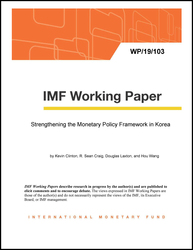
Strengthening the Monetary Policy Framework in Korea
Adoption of inflation targeting by the Bank of Korea (BOK) in 1998 contributed to low and stable inflation. However, after the global financial crisis (GFC) monetary policy faced more challenging conditions. Inflation slipped below the target range in 2012 and remains below it despite a cut in the target to 2 percent in 2016. Policy also became more complex with the addition of financial stability to the central bank’s mandate. To address these challenges, this paper proposes a two-pronged approach to strengthen the effectiveness with which monetary policy can meet its objectives: first, enhanced communication on how the target will be achieved over the medium-term, building on a forecasting and policy analysis system; and, second, by clarifying the complementary role of macroprudential policy in containing financial stability risks so that monetary policy can focus on the inflation target. Simulation of a macro model calibrated to Korea illustrates how it can be used to provide this greater medium-term focus on achieving the inflation target and strengthen communication.
Publication date: May 2019
ISBN: 9781498312226
$18.00
Add to Cart by clicking price of the language and format you'd like to purchase
Available Languages and Formats
| English |
Prices in red indicate formats that are not yet available but are forthcoming.
Topics covered in this book
This title contains information about the following subjects.
Click on a subject if you would like to see other titles with the same subjects.
Korea , inflation targeting , output gap , ELB , inflation target , BOK , GFC
Summary
Copyright © 2010 - 2024
Powered by:
AIDC



